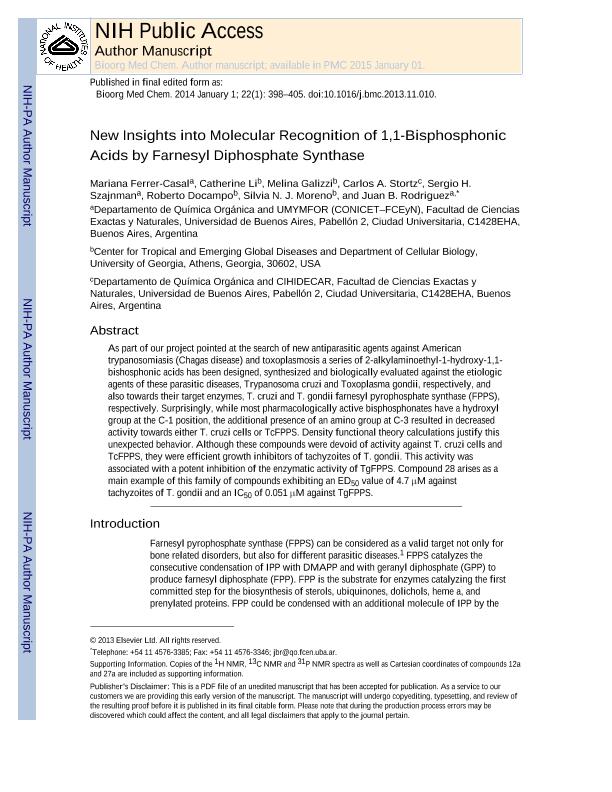Artículo
New Insights into Molecular Recognition of 1,1-Bisphosphonic Acids by Farnesyl Pyrophosphate Synthase
Ferrer, Mariana ; Li, Catherine; Gallizi, Melina; Stortz, Carlos Arturo
; Li, Catherine; Gallizi, Melina; Stortz, Carlos Arturo ; Szajnman, Sergio Hernan
; Szajnman, Sergio Hernan ; Docampo, Roberto; Moreno, Silvia N. J.; Rodriguez, Juan Bautista
; Docampo, Roberto; Moreno, Silvia N. J.; Rodriguez, Juan Bautista
 ; Li, Catherine; Gallizi, Melina; Stortz, Carlos Arturo
; Li, Catherine; Gallizi, Melina; Stortz, Carlos Arturo ; Szajnman, Sergio Hernan
; Szajnman, Sergio Hernan ; Docampo, Roberto; Moreno, Silvia N. J.; Rodriguez, Juan Bautista
; Docampo, Roberto; Moreno, Silvia N. J.; Rodriguez, Juan Bautista
Fecha de publicación:
01/2014
Editorial:
Elsevier
Revista:
Bioorganic
ISSN:
0968-0896
Idioma:
Inglés
Tipo de recurso:
Artículo publicado
Clasificación temática:
Resumen
As part of our project pointed at the search of new antiparasitic agents against American trypanosomiasis (Chagas disease) and toxoplasmosis a series of 2-alkylaminoethyl-1-hydroxy-1,1-bisphosphonic acids has been designed, synthesized and biologically evaluated against the etiologic agents of these parasitic diseases, Trypanosoma cruzi and Toxoplasma gondii, respectively, and also towards their target enzymes, T. cruzi and T. gondii farnesyl pyrophosphate synthase (FPPS), respectively. Surprisingly, while most pharmacologically active bisphosphonates have a hydroxyl group at the C-1 position, the additional presence of an amino group at C-3 resulted in decreased activity towards either T. cruzi cells or TcFPPS. Density functional theory calculations justify this unexpected behavior. Although these compounds were devoid of activity against T. cruzi cells and TcFPPS, they were efficient growth inhibitors of tachyzoites of T. gondii. This activity was associated with a potent inhibition of the enzymatic activity of TgFPPS. Compound 28 arises as a main example of this family of compounds exhibiting an ED50 value of 4.7 μM against tachyzoites of T. gondii and an IC50 of 0.051 μM against TgFPPS.
Palabras clave:
Bisphosphonic Acid
,
Recognition
,
Molecular Modeling
Archivos asociados
Licencia
Identificadores
Colecciones
Articulos(CIHIDECAR)
Articulos de CENTRO DE INVESTIGACIONES EN HIDRATOS DE CARBONO
Articulos de CENTRO DE INVESTIGACIONES EN HIDRATOS DE CARBONO
Citación
Ferrer, Mariana; Li, Catherine; Gallizi, Melina; Stortz, Carlos Arturo; Szajnman, Sergio Hernan; et al.; New Insights into Molecular Recognition of 1,1-Bisphosphonic Acids by Farnesyl Pyrophosphate Synthase; Elsevier; Bioorganic; 22; 1; 1-2014; 398-405
Compartir



